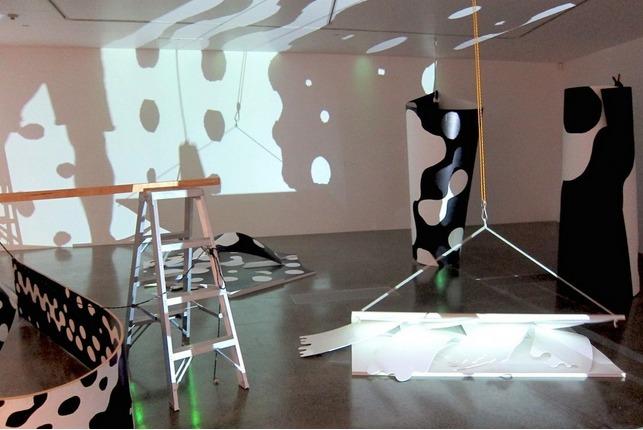First published in i-D May 2015
In the past decade, acclaimed New Zealand artist Judy Millar‘s varied work has filled a German gallery with Technicolor tidal waves and unspooled wild brushstrokes across the walls of a Renaissance church for the 53rd Venice Biennale. Always a fan of an enveloping spectacle, her latest show Reverse Cinema at Sydney’s Sullivan + Strumpf draws on painting, sculpture, and light projections to create an installation that’s both soulful and cerebral. With the show involving her most audacious work yet, i-D chatted with the artist about her allergy to categories, falling in love as an intellectual experiment, and why she dreads public art.
How has your practice evolved since you started?
It’s impossible to say because it’s a very curious process: you just fire an arrow and find out where that arrow is going to land, but it just never lands. I’m a self-taught artist because when I was at art school, we were just left to sort things out and I was always playing with many mediums. I might start with a very direct painting process but I’ve never known when one medium ends and the other begins.
Why are you fascinated by physicality?
I’m curious about the edge of the physical and the mental, and where that exists. All my work is in some way about the relationship between these two things. We live our lives constantly juggling these worlds but they can seem pretty contradictory. We have dreams all the time, we imagine things all the time, and we build a mental life for ourselves. But we never truly know what another person is thinking. All the most important moments of our lives—falling in love, losing somebody, death—are times where we encounter this edge. Falling in love is the perfect example of our physical and mental selves colliding.
You live between New Zealand and Berlin. How are you influenced by moving between these places?
I live in a very remote place in New Zealand, on the edge of the Tasman Sea about an hour outside Auckland. The shift between the two places makes me constantly reassess what I’m doing, which is why I keep doing it. I like to leave work unfinished when I leave Berlin and go back to New Zealand. It’s fascinating because when I go back, I always see it with new eyes.
Reverse Cinema is your first interactive installation. How did you dream up this work and bring it to life?
Some of the challenges really were about how to engineer aspects of it—I’m not very good at making things so I rely a lot on working with people who can translate what I’m wanting. I’m often painting on my own so I really appreciate working with different minds.
I’ve always been interested in how images circulate and shift in the culture. This work is like an exploded painting: it started as a painting and got converted into a screen print. After that I thought I would project those images onto forms and then into space. I also photographed three-dimensional forms and printed them digitally into these flat images, so the installation folds back in on itself. This seems to be the way we experience the world.
What’s next for you?
I’m working on my first public sculpture. I’m not a fan of the medium but thought I would try! The worst examples of this are large lumps of metal that are just plonked in our environment where they shouldn’t be. I’m working on a piece that in some ways is a bit of a lampooning of what public sculpture is for Christchurch, a city that’s folded down and is folding back up again. I think the best public sculptures get nicknames and that’s how I’ll know if mine works! If it hasn’t got one it hasn’t entered people’s psyches yet.
‘Reverse Cinema’ shows at Sullivan + Strumpf Gallery in Sydney from the 23 May to 13 June.

